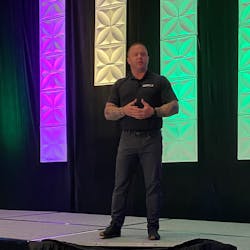Two keynotes at the 2023 executive conference of the Control System Integrators Association (CSIA) provided stimulating fodder for companies looking to move forward in the changing landscape of automation.
Mike Maddock, CEO and founding partner at Maddock Douglas, presented “The Questions Disruptors Ask Themselves,” a keynote speech he’s delivered to multiple organizations. And JP Dinnell, a leadership instructor, speaker and strategic advisor at Echelon Front, as well as a former U.S. Navy Seal, shared how the rules of engagement translate to the business world.
“Companies are being punched in the face by the future,” said Maddock. “You see a need in the market. You prototype it. And you test it, you test it, and you test it. And then you launch it.”
Maddock asked three disruptor questions:
1. Do I have a yin for your yang?
2. How do innovators see opportunities?
3. Under pressure, do your teams create or complain?
“Don’t ever stop looking for treasure,” emphasized Maddock, who cited multiple examples of disruptors, or idea monkeys, who made their own ways and often found complementary partners to join them on their treasure hunts and find the location where X marks the spot.
In the 1980s, Larry Walters, who couldn’t obtain a pilot’s license because of his eyesight, got his idea for flight off the ground by tethering helium-filled weather balloons to a lawnchair. Inspiration I, as the apparatus came to be named, soared much higher than anticipated, reaching 16,000 feet before descending into power lines. Walters survived the flight but died a little over a decade later; however, the chair still can be found in the Smithsonian Institute.
“Wherever there’s a great invention, there’s an idea monkey, like Larry Walters or Richard Branson or Walt and Roy Disney,” explained Maddock, who stressed the importance of having a yin for a yang by noting not just the Disneys, but the Wrights, as brotherly duos who paired well.
“If you’re like Walt Disney or Orville Wright, you’re a lateral thinker,” Maddock said. Ringleaders, such as Roy Disney or Wilbur Wright, are systems thinkers or critical thinkers, which idea monkeys need to turn their creative concepts into disruptive realities.
The differences between idea monkeys and ringleaders are identifiable through comparisons made by Maddock:
• Where idea monkeys diverge, ringleaders converge.
• Where idea monkeys predict it, ringleaders prove it.
• Where idea monkeys are about ideas, ringleaders are about process.
• Where idea monkeys are 3-3-9-3 in the Kolbe Quick Start cluster, ringleaders are 8-8-3-3 in the Kolbe Fact Finder cluster.
• Where idea monkeys tend to aim after firing, ringleaders plan and execute with precision.
• Where idea monkeys believe anything is possible, ringleaders make sure it is possible.
• Where idea monkeys are energetic, sparkle-fingered cheerleaders, ringleaders stay calm, stay focused and stay the course.
Disruptors must be engaged through conversion and diversion, said Maddock. Seeing opportunities often involves stepping back for perspective.
“You can’t read the label when you’re sitting inside the jar,” he explained. This is called marketing myopia.
“If the railroad barons understood they were in the travel business, they would have owned every plane, car and ship, but they thought they were in the train business,” cautioned Maddock.
“Disruptors get curious, not furious,” explained Maddock, who posed three questions to direct results:
• What is the outcome I want?
• What stands in the way?
• Who has already figured this out?
“When we’re tired and exhausted, we tend to make mistakes because we’re not being logical,” he explained. “That fatigue makes cowards of us all. How many times has that little voice in your head tell you that you should play it safe and go and do something else? You would not have the life you have if you listened to that voice that told you to play it safe and not do the extra work.”
Dinnell’s mindset let him take his training to the next level, he said and offered tips on leadership through the laws of combat:
1. Cover and move: “It’s a gunfighting technique. It’s the only tactic we use all of the time,” Dinnell explained. Teamwork means working together with no silos. “If the team fails, everyone fails.”
2. Simplicity: “We have to be able to communicate with the people around us, clearly and concisely,” he stressed.
3. Prioritize and execute: Detach from the situation. Relax, look around, and make a call. “What is going to have the biggest impact on the mission? If I can detach and assess what is going on around me, it lets me make a more logical decision,” Dinnell explained.
4. Decentralized command: Everyone leads. “Team must understand not just what to do, but why,” he noted. “Don’t wait for orders; lead.”
Dinnell conveyed additional mindsets for victory. “Discipline equals freedom,” he said. “There are standard operating procedures for everything, not rigid, but flexible, agile, dynamic and highly efficient. Don’t be afraid to think. Even the best procedures don’t work in all situations. Our default is to be aggressive. The battlefield changes. The enemy adjusts. New tactics emerge. Technology evolves. Educate yourself. Our tendency is to resist change. Be humble. Check your ego.”
About the Author
Mike Bacidore
Editor in Chief
Mike Bacidore is chief editor of Control Design and has been an integral part of the Endeavor Business Media editorial team since 2007. Previously, he was editorial director at Hughes Communications and a portfolio manager of the human resources and labor law areas at Wolters Kluwer. Bacidore holds a BA from the University of Illinois and an MBA from Lake Forest Graduate School of Management. He is an award-winning columnist, earning multiple regional and national awards from the American Society of Business Publication Editors. He may be reached at [email protected]

Leaders relevant to this article:


